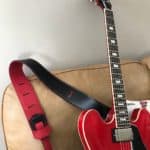Playing guitar is a joyful experience. It boosts our creativity, reduces stress, enhances concentration, and makes us better listeners.
Unfortunately, not everything in the garden is rosy. Playing guitar also exhausts us a lot.
Truth is, playing guitar is a way of doing exercise too. Not to mention, it creates callouses in the tip of our fingers and even generates back pain when we play in the wrong position.
Sure, and the weight of the guitar itself will also make a difference.
Of course, the heavier the guitar, the more tired we’ll get after playing.
Having light guitar models is great to avoid future pain, but what happens if your guitar is not light at all?
What if it’s too heavy? Is there a way in which you can make your guitar lighter?
Luckily, there is, and not just one, but plenty.
Among the easiest ways of making your guitar lighter, we find replacing metal tuning knobs and strap buttons with plastic, changing pickups and bridges, and removing some wood from the instrument. Naturally, some of these tricks need to be handled by professionals.
Find out which of these 10 tips will end up being implemented in your guitar. Maybe all of them, who knows?
A word of warning before beginning: consider that many of these implementations could change your guitar tone forever, so don’t risk sound for comfort if you’re hesitating.
With that said, here we go!
1. Plastic!
Why not make your guitar lighter while simultaneously saving the environment?
Indeed! Changing metal parts for their plastic counterparts is a wise way in which you can get rid of some weight and recycle plastic at the same time.
After all, plastic is lighter than metal, and the more aspects you replace with it, the lighter your guitar will become.
But what are these parts specifically?
Well, of course, we’re referring to the tiny pieces of your guitar, not the wood body!
See if you can replace your tuning knobs (or any other knob, really) and strap buttons with a plastic material alternative.
2. Strap
Focus not only on the guitar itself but on everything related to it. To be more precise, try to change the strap.
Believe it or not, the guitar’s strap can weigh too much. So, stick to one that is both secure and light.
But don’t look up just that. Find a strap that is wider than the average.
Naturally, wider straps help spread the weight of the instrument.
Oh, yeah! And don’t forget to replace the metal strap buttons with some plastic ones.
3. Bridge
Check if changing your current bridge makes a difference. Generally, it does.
Guitar bridges are made of metal too, of steel or brass. So, it’s convenient to look for another type of metal that weighs much less, such as aluminum.
Also, see if you can get your hands on a bridge that’s made with less amount of material (a thinner bridge).
4. Finish
Is your guitar covered in a polyurethane finish? If that’s the case, then you might consider getting rid of it.
Poly finishes add weight to the instrument since they are thicker and stronger in comparison to other materials like nitrocellulose.
The advantage of a poly finish is that being more resistant makes it less likely to crack or damage. But, of course, it also makes your guitar heavier.
So, if you care more about weight rather than paint, gently remove the current finish with sandpaper and apply a lighter one.
5. Pickups
The more pickups you have, the more weight it adds to the instrument.
If you have three pickups, for example, maybe you could get by with just one or two.
Moreover, the type of pickup you play with also affects its heaviness. Check for lighter models.
6. The drill-press method
Luthiers use a drill press to carve holes into the guitar’s body.
Although it seems like a horrible crime to your beloved guitar, it’s nothing but a meticulous process that eliminates some load off of it.
The drill press passes through the guitar’s body and makes some holes in it. These holes are lined-up in a pattern to take up the most space without interfering with the instrument’s structure.
Needless to say, this job should be handled by an expert. Otherwise, you run the risk of permanently damaging the guitar.
Also, consider whether a lighter guitar is worth the holes in your guitar’s body or not.
If you think it will look cooler, then go for it. Otherwise, just stay away from this idea.
7. Keep removing wood
If you were not convinced by the making-holes-into-the-body approach, then there are some alternatives that include eliminating wood.
Certain areas of the guitar have “extra” wood, that barely affects its playability if removed.
One of them is the heel. Another is the headstock.
Regarding this last one, consider that it will only be plausible if the headstock has all the tuning pegs on one side of it.
In other words, if the six pegs are on the “upper” side of the headstock, then you must remove wood from the opposite area.
In addition, you can sand the guitar’s neck to make it thinner (and so, lighter).
8. Neck plate
Go to the back of your guitar.
See the neck plate? Good, take it out.
Do you feel your guitar lighter now? Maybe the difference is not too big to notice, but it’s a great addition (or subtraction) when combined with other tips on this list.
9. Change the wood
If you feel hesitant to get rid of wood from the guitar, then maybe you can choose the alternative, which is simply to change from one type of wood to another.
The wood from the guitar’s body and fretboard may be replaced on some occasions for a lighter one.
Basswood, for example, is one of the lightest types of them all. However, it cannot be used on fretboards.
Also, bear in mind that wood affects the tone of the instrument, so forget about this step if you don’t want to interfere with your current guitar’s sound.
10. From solid to semi-hollow
This tip is related to the drill method. However, making a semi-hollow guitar is different than simply adding holes to the body.
In both cases, the tone of the guitar will be changed forever. However, we believe that going from a solid body to a semi-hollow changes the tone the most.
Once again, check whether your guitar model can be transformed or not because this is not something that can be done to every guitar.
Or maybe just get a lighter guitar
Now, if your goal is to play with a relatively lighter guitar, there are two things you can do about it.
First of all, you can implement one, two, five, or all of the tips mentioned above. The more you apply, the lighter your guitar will be.
Watch out, you don’t want it to levitate towards the sky and lose it forever!
The other option is simply to purchase a lighter guitar and save you the time of implementing the tips.
A hollow or semi-hollow guitar will always be lighter. However, bare in mind that its structure plays a drastic role in the sound.
Nonetheless, there are regular electric guitars that are made from lighter wood, as we have already mentioned.
If you don’t know which models are lighter, you can always ask for advice at the guitar store, or check for any blog or Youtube video review.
In addition, you can always try the instrument yourself and check whether its weight feels appropriate or not.
Make sure you’re as comfortable as you can when playing guitar. This will boost your motivation to keep on playing.
The more comfortable you are with the instrument, the more you’ll enjoy it. And the more you enjoy it, the more you’ll play it, and the more you’ll learn.

Hello there, my name is Ramiro and I’ve been playing guitar for almost 20 years. I’m obsessed with everything gear-related and I thought it might be worth sharing it. From guitars, pedals, amps, and synths to studio gear and production tips, I hope you find what I post here useful, and I’ll try my best to keep it entertaining also.





